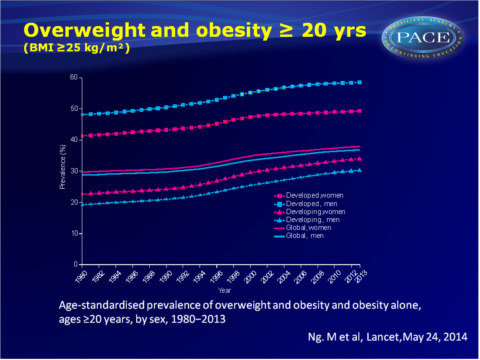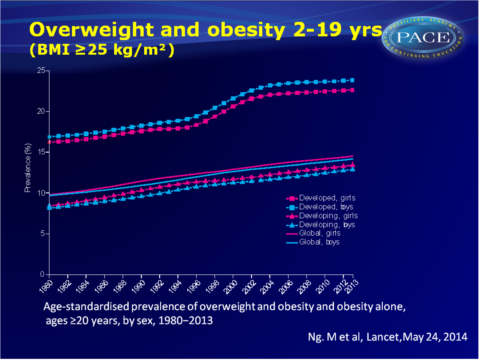Overweight and obesity increasingly prevalent over past 3 decades
03/06/2014
Both developed and developing countries showed an increased prevalence of overweight and obesity. The increase slowed down in the past decade, but no national success stories are observed.
Global, regional, and national prevalence of overweight and obesity in children and adults during 1980-2013: a systematic analysis for the Global Burden of Disease Study 2013News - June 3, 2014
Ng M, Fleming T, Robinson M, et al.
Lancet. 2014 May 28. doi: 10.1016/S0140-6736(14)60460-8
Obesity has become a major global health challenge, due to its increasing prevalence and established health risks. A new study that estimated global, regional, and national prevalence of overweight and obesity in children and adults showed a continued increase between 1980 and 2013.
Similar trends were seen for men and women, with increases from 28.8% (95%UI: 28.4-29.3) to 36.9% (95%UI: 36.3-37.4) worldwide in men and from 29.8% (95%UI: 29.3-30.2) to 38.0% (37.5%-38.5) in women. The increases were seen in both developed and developing countries, but with different gender patterns. More men were overweight or obese in developed countries, while those conditions were more prevalent in women in developing countries.
In children and adolescents (<20 years old), prevalence of obesity and overweight also increased substantially, both in developed and developing countries. In developed countries, 23.8% (95%UI: 22.9-024.7) of boys and 22.6% (95%UI: 21.7-23.6) of girls were obese or overweight. In developing countries, prevalence increased from 8.1% (95%UI: 7.7-8.6) to 12.9 (95%UI: 12.3-13.5) in 2013 for boys, and from 8.4% (95%UI: 8.1-8.8) to 13.4% (95%UI: 13.0-13.9) in girls. Sex differences in levels and trends of overweight and obesity were small in children and adolescents, in both developed and developing countries.
Patterns differ substantially between countries. The findings suggest that increases in obesity during the study period were not smaller in countries that already had high rates of obesity, as the USA was among the top 15 countries with the highest increases in obesity for men and women. In 2013, the USA accounted for 13% of all obese people worldwide. 62% of the world’s obese individuals live in developing countries.
The prevalence of overweight and obesity increases most strongly between 1992 and 2002. Over the past decade, the increase in adult obesity has slowed down in developed countries. The authors note, however, that no national success stories have been reported in the past 33 years; no downward trends have been documented in the past decades. Urgent action is needed to make interventions and prevention more effective, to counter the impending health effects on populations
Download Ng Lancet 2014 PACE.pptx


Find this article on Pubmed
